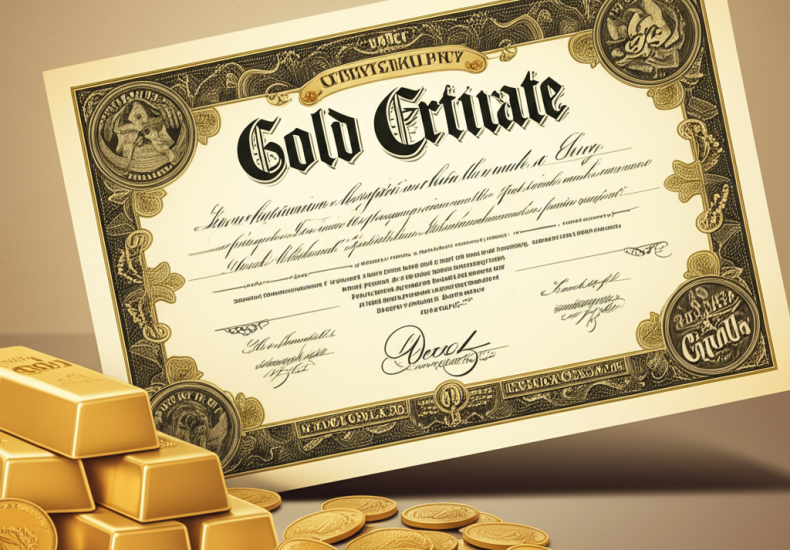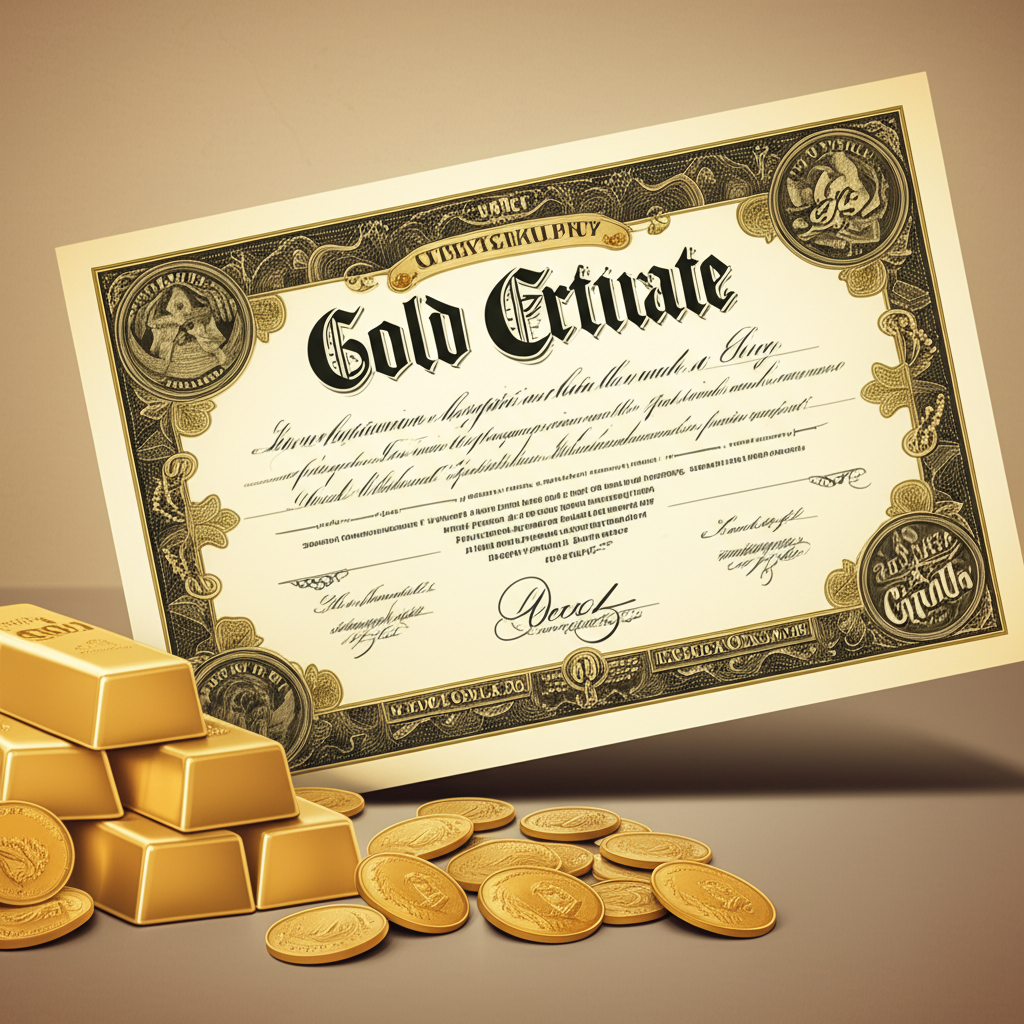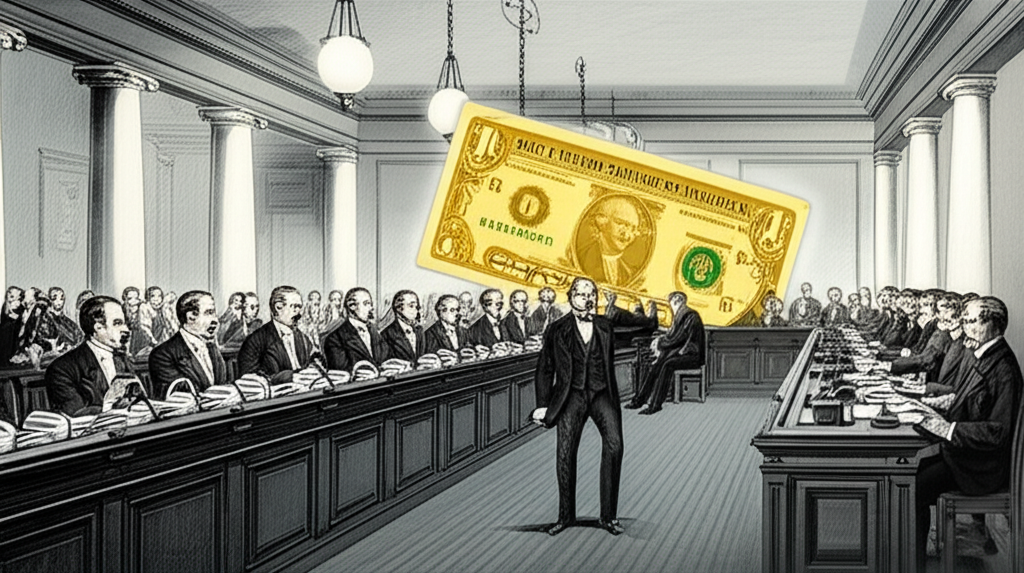
Gold Certificates Definition Economics: What Happened to America’s Gold-Backed Money?
Table of Contents
ToggleIntroduction: What Are Gold Certificates in Economics?

In the landscape of monetary history, few instruments capture the essence of trust-backed currency quite like the gold certificate. At its core, a gold certificate is a form of representative money—a paper note that once served as a direct and legally enforceable claim on a specific quantity of physical gold held by a government or central authority. Unlike ordinary promissory notes, these certificates weren’t just promises; they were hard guarantees. Anyone holding one could, at any time, walk into a designated financial institution and exchange it for an equivalent amount of gold coin or bullion. This immediate convertibility was the foundation of public confidence in paper currency during an era when the tangible value of money mattered above all else.
Gold certificates emerged as a practical solution to a growing economic challenge: how to conduct large-scale commerce without the logistical burden of transporting heavy gold. By representing gold in a portable, durable form, they allowed for smoother transactions while preserving the stability associated with a metallic standard. Their role was especially critical in economies operating under the gold standard, where the value of a nation’s currency was directly tied to its gold reserves. In this context, gold certificates weren’t just convenient—they were essential. They bridged the gap between the reliability of precious metal and the efficiency of paper, becoming a key mechanism for maintaining monetary integrity and facilitating national and international trade. This article explores their origin, function, transformation, and lasting influence in both economic thought and the world of collectibles.
A Historical Overview: Gold Certificates in the United States Monetary System

The story of gold certificates in the United States reflects broader transformations in the nation’s financial philosophy. What began as a specialized tool for interbank settlements evolved into a widely circulated currency before ultimately being withdrawn from public use—a journey that mirrors America’s departure from strict commodity-backed money toward a more flexible, government-managed monetary system.
The Genesis and Early Function of Gold Certificates
Introduced in 1863 amid the financial pressures of the Civil War, gold certificates were initially designed for institutional use. The U.S. Treasury issued them in large denominations—$100, $500, $1,000, and higher—making them unsuitable for everyday transactions but ideal for moving vast sums between banks and government accounts. At a time when transporting physical gold was risky and inefficient, these certificates offered a secure, lightweight alternative. Each note carried a clear declaration: it could be redeemed on demand for its face value in gold coin at any U.S. Treasury facility. This assurance wasn’t symbolic—it was a legal obligation that underpinned the credibility of the entire system.
As confidence in paper money grew and printing technology improved, the government began issuing smaller denominations, such as $10 and $20, making gold certificates accessible to private citizens. By the late 19th and early 20th centuries, they circulated alongside other forms of U.S. currency, including silver certificates and United States Notes. For the average American, holding a gold certificate meant possessing something almost as good as gold itself—portable, widely accepted, and backed by a national store of precious metal. Their design, often featuring elaborate engravings and intricate security elements, reinforced their legitimacy and prestige.
The Pivotal Role of the Gold Reserve Act of 1934
The collapse of public confidence in banks during the Great Depression triggered a seismic shift in U.S. monetary policy. Widespread panic led to a massive run on gold, as individuals and institutions rushed to convert paper currency into physical metal. This surge in redemptions threatened to deplete the nation’s gold reserves, destabilizing the dollar and undermining international trade. In response, President Franklin D. Roosevelt took unprecedented action. On April 5, 1933, he issued Executive Order 6102, which required U.S. citizens to surrender all gold coins, bullion, and gold certificates in exchange for paper currency. Personal possession of monetary gold was effectively outlawed, with exceptions made only for collectors, jewelers, and industrial users.
This emergency measure was cemented into law with the passage of the Gold Reserve Act of 1934. Enacted on January 30 of that year, the Act transferred all monetary gold in private and institutional hands to the U.S. Treasury, consolidating national control over the country’s reserves. It also revalued gold from $20.67 per troy ounce to $35—an artificial increase that boosted the Treasury’s balance sheet and allowed the Federal Reserve to expand the money supply, a key move intended to fight deflation and stimulate economic recovery. Crucially, the Act severed the public’s right to redeem gold certificates for physical gold. From that point forward, these notes ceased to be a feature of daily economic life.
Instead, gold certificates were repurposed for internal use within the Federal Reserve System. They became accounting tools, used to track the gold assets held by the Treasury on behalf of the central bank. Though no longer in public circulation, they remained part of the official balance sheets, symbolizing a lingering link to gold even as the U.S. moved decisively toward a fiat currency framework. For those interested in the legislative details and economic rationale behind this turning point, the Federal Reserve Archival System for Economic Research (FRASER) offers a comprehensive collection of documents and analyses: FRASER: Gold Reserve Act of 1934.
Economic Mechanics: How Did Gold Certificates Operate?

The functionality of gold certificates was rooted in a simple but powerful principle: convertibility. Their existence was not based on government decree alone, but on a concrete, enforceable promise. This mechanism was central to the operation of the gold standard and played a vital role in shaping economic behavior, public trust, and monetary policy.
Redeemability, Trust, and Monetary Stability
The most defining feature of a gold certificate was its explicit guarantee of redemption. Every note issued by the Treasury or later by the Federal Reserve contained wording that assured the bearer they could exchange it for a fixed amount of gold upon presentation. This wasn’t a vague promise—it was a legal commitment, enforceable under federal law. In an era when skepticism toward paper money was common, this tangible link to gold provided a psychological and financial anchor. People didn’t need to trust the abstract value of currency; they trusted the gold behind it.
This system fostered a high degree of monetary stability. Because the government was obligated to honor redemptions, it couldn’t arbitrarily print more money without risking a depletion of its gold reserves. This self-imposed discipline helped curb inflation and maintained the purchasing power of the dollar over long periods. Businesses could plan for the future with greater certainty, investors felt secure knowing their capital was protected by a stable currency, and international trade flourished under predictable exchange rates. The gold certificate, in this sense, was more than a transactional tool—it was a symbol of fiscal responsibility and economic order.
Influence on Money Supply and Gold Standard Adherence
Under the gold standard, the total supply of money in circulation—including gold certificates, silver certificates, and other forms of paper currency—was constrained by the nation’s gold holdings. This created a direct, mechanical link between economic policy and physical reality. If the U.S. acquired more gold—through mining, trade surpluses, or foreign inflows—the Treasury could issue additional gold certificates, effectively expanding the money supply. Conversely, if gold reserves shrank due to outflows or redemptions, the money supply had to contract to maintain the fixed ratio.
This built-in limitation prevented excessive monetary expansion and acted as a natural check on government spending. Gold certificates, therefore, functioned as a flexible yet disciplined component of the broader monetary base. They allowed for liquidity in the economy without sacrificing the integrity of the gold standard. For central bankers and policymakers of the time, managing the issuance of these certificates was a balancing act—ensuring enough currency for economic growth while safeguarding the nation’s ability to meet redemption demands. Their use reflected a world where money derived its value not from faith in government, but from a universally recognized store of value: gold.
The Modern Status of Gold Certificates: Value, Legality, and Collectibility

Though they no longer serve any functional role in the U.S. economy, historical gold certificates have found a new life—as prized artifacts in the world of numismatics. Their significance today lies not in their face value or legal status, but in their rarity, craftsmanship, and the historical narratives they embody.
Are Historical Gold Certificates Still Legal Tender or Redeemable?
A common question among collectors and curious observers is whether old gold certificates can still be used like regular money or exchanged for gold. The answer is clear: they are no longer redeemable for physical gold by the public, nor are they actively used in commerce. The Gold Reserve Act of 1934 permanently ended their status as convertible currency. While the U.S. Department of the Treasury acknowledges that these notes remain legal tender at their face value—meaning you could theoretically spend a $20 gold certificate as $20 in current dollars—no one does so. The real value lies far beyond the printed number.
Attempting to redeem a gold certificate for gold at a bank would be met with confusion, if not amusement. The legal framework for such exchanges vanished nearly a century ago. Today, these notes are treated as historical relics, preserved in collections, displayed in museums, or traded among enthusiasts. Their withdrawal from circulation marks a turning point in American financial history—the moment when the dollar began its transition from a gold-anchored currency to one based on government credit and public confidence.
The Numismatic Perspective: Uncovering the Value of Old Gold Certificates
For collectors, gold certificates represent a golden thread connecting the past to the present. Their market value is determined not by economic utility, but by the principles of scarcity, condition, and historical significance. A $20 note from the 1928 series might have been worth two gold double eagles in its time, but today it can sell for hundreds or even thousands of dollars, depending on its grade and pedigree.
Rarity plays a major role. Some series were printed in limited quantities, while others were heavily redeemed and destroyed during the 1930s, leaving only a few survivors. Certificates with unique serial numbers, star notes, or printing errors are particularly sought after. Condition is equally critical. A note graded as “uncirculated” with sharp corners, vibrant ink, and no folds or stains can command a premium, sometimes exceeding $10,000. Higher denominations—such as $500, $1,000, or the rare $10,000 notes used exclusively between banks—are exceptionally scarce and can reach six-figure prices at auction.
Design also influences value. The 1905 “Technicolor” series, known for its rich green and gold hues, is a favorite among collectors for its aesthetic appeal. Notes bearing the signatures of notable Treasury officials or those issued during pivotal moments in history often carry added prestige. To accurately assess a certificate’s worth, collectors turn to professional grading services like Paper Money Guaranty (PMG) or the Professional Coin Grading Service (PCGS). These organizations authenticate and assign a numerical grade, which is essential for establishing credibility in the marketplace. Platforms like Heritage Auctions and Coin World offer extensive databases and past sale records, helping collectors benchmark value and track market trends.
Historical Gold Certificates vs. Modern Gold Ownership Instruments
The way people own and interact with gold has changed dramatically since the era of gold certificates. While the fundamental desire to hold a tangible store of value remains, the methods have evolved to suit a digital, globalized economy.
| Feature | Historical Gold Certificates (Pre-1934 U.S.) | Modern Gold Ownership Instruments |
| :———————- | :————————————————————————————— | :—————————————————————————————————————————————————————————————————————————————————————————————– |
| **Form** | Paper currency, direct claim on physical gold held by government. | **Physical Bullion:** Bars, coins (stored privately or in vaults).
**Gold ETFs (Exchange-Traded Funds):** Shares representing ownership of gold held by a trust.
**Digital Gold:** Fractional ownership of physical gold, managed via online platforms.
**Allocated/Unallocated Accounts:** Accounts representing direct or indirect ownership of gold held by a bank/refiner. |
| **Redeemability** | Directly redeemable for physical gold by the public (until 1934). | **Physical Bullion:** Direct ownership.
**Gold ETFs:** No direct redemption for physical gold; shares traded on exchanges.
**Digital Gold:** Varies by platform; some offer physical delivery for larger holdings.
**Accounts:** Varies; allocated accounts offer direct claim, unallocated do not. |
| **Legal Tender Status** | Yes (until 1934). | No (physical gold coins may have face value, but market value is much higher). |
| **Primary Purpose** | Medium of exchange, convenient substitute for physical gold in a monetary system. | Investment, hedge against inflation, store of value, portfolio diversification. |
| **Risk Factors** | Government confiscation (e.g., EO 6102), changes in monetary policy, counterfeiting. | Price volatility, storage costs/risks (physical), counterparty risk (digital/ETFs/accounts), regulatory changes, market liquidity. |
| **Accessibility** | Widely circulated and accepted for transactions. | **Physical Bullion:** Purchase from dealers.
**Gold ETFs:** Easily bought/sold on stock exchanges.
**Digital Gold:** Online platforms, low entry barriers.
**Accounts:** Bank/financial institution services. |
| **Current Value** | Primarily numismatic (collector) value, far exceeding face value. | Market value tied directly to the spot price of gold. |
| **Relation to Monetary System** | Integral part of a gold-backed monetary system. | Generally separate from sovereign monetary systems (except for central bank reserves). |
This comparison highlights a fundamental shift: from a system where gold underpinned everyday money, to one where gold functions primarily as an investment asset. The disappearance of gold certificates from circulation reflects a broader move toward fiat currencies and financial innovation, where value is derived from trust in institutions rather than physical backing.
Conclusion: The Enduring Economic and Historical Legacy of Gold Certificates
Gold certificates occupy a unique place in the annals of American economic history. They were more than just paper—they were a promise, a system, and a symbol of an era when money had a physical anchor. From their origins as tools for interbank transfers to their role in daily commerce, they embodied the principles of the gold standard: stability, discipline, and trust. Their decline, triggered by the economic turmoil of the 1930s and formalized by the Gold Reserve Act, marked a watershed moment in U.S. financial policy. It signaled the end of a rigid commodity standard and the beginning of a more flexible, interventionist approach to monetary management.
Today, their legacy endures in two distinct realms. Economically, they serve as a case study in the strengths and limitations of commodity-backed currencies. They illustrate how convertibility can foster confidence, but also how rigid adherence to gold can constrain policy during crises. Historically, they are treasured as artifacts—beautifully crafted documents that tell the story of a nation’s financial evolution. Their value as collectibles speaks to a deep cultural fascination with money, scarcity, and the enduring allure of gold. Whether displayed in a frame or stored in a protective sleeve, a gold certificate is more than a relic; it’s a tangible connection to a time when paper money wasn’t just a promise—it was a receipt for gold.
Frequently Asked Questions About Gold Certificates
What is the primary economic definition of a gold certificate?
In economics, a gold certificate is a type of representative money, a paper currency that provided a direct, legal claim on a specific amount of physical gold (bullion or coin) held in reserve by the issuing government or central bank. It allowed for easier transaction of gold without the need to physically move or store the metal itself.
When were gold certificates first issued and primarily used in the United States monetary system?
Gold certificates were first issued in the United States in 1863, primarily for interbank and Treasury transactions. They gained wider public circulation and use from the late 19th century until 1933-1934, when their public redeemability and circulation ceased due to federal legislation.
Are historical gold certificates still redeemable for physical gold by the public today?
No, historical gold certificates are no longer redeemable for physical gold by the public. The Gold Reserve Act of 1934 ended their public redeemability and circulation. While they can be exchanged for their face value in current U.S. currency, their collector’s value far exceeds this.
What economic role did gold certificates play under the gold standard?
Under the gold standard, gold certificates served as a convenient and trusted medium of exchange directly backed by gold reserves. They facilitated commerce, provided monetary stability by linking the money supply to physical gold, and instilled public confidence in the currency through their explicit promise of redeemability.
What major historical events or legislation led to the discontinuation of gold certificates for public circulation?
The primary events and legislation were:
- **Executive Order 6102 (1933):** Required U.S. citizens to surrender their gold coins, bullion, and gold certificates to the Federal Reserve.
- **Gold Reserve Act of 1934:** Nationalized all monetary gold in the U.S. and officially ended the public redeemability and circulation of gold certificates, revaluing gold from $20.67 to $35 per troy ounce.
Do old $20 gold certificates or other denominations hold any significant collector’s value today?
Yes, many old gold certificates, including $20 denominations, can hold significant collector’s (numismatic) value. This value is determined by factors such as rarity, physical condition (grade), series, and historical significance, often far exceeding their original face value.
How do gold certificates differ from modern forms of gold ownership, such as gold ETFs or digital gold?
Historical gold certificates were legal tender and direct claims on government-held gold, used as circulating currency. Modern gold ETFs (Exchange-Traded Funds) are investment vehicles representing fractional ownership of gold bullion, traded on stock exchanges, and are not legal tender. Digital gold involves online platforms for buying and selling fractional gold ownership. Both modern forms are primarily for investment rather than everyday transactions, and carry different risks and accessibility compared to historical certificates.
What is the distinction between a “gold certificate” and general “gold certification” for products or standards?
A “gold certificate” (as discussed here) is a specific historical paper currency backed by gold. “Gold certification” generally refers to a process or standard applied to products, services, or individuals to indicate a certain level of quality, achievement, or adherence to specific criteria (e.g., gold standard for environmental buildings, gold record for music sales, or certification of a product as containing real gold).
Can gold certificates be considered legal tender in the current U.S. financial system?
While historical gold certificates technically retain their face value as legal tender and can be exchanged for current U.S. currency at a bank, they are no longer actively circulated or accepted in commercial transactions. Their primary value today is as collector’s items, not as a medium of exchange in the modern financial system.
Where can I find reliable information on authenticating and valuing historical gold certificates?
Reliable information can be found through professional numismatic organizations such as the American Numismatic Association (ANA), professional grading services like Paper Money Guaranty (PMG) or Professional Coin Grading Service (PCGS), and reputable numismatic dealers and auction houses. These sources provide authentication services, grading standards, and market value insights based on recent sales.
You may also like
Calendar
| 一 | 二 | 三 | 四 | 五 | 六 | 日 |
|---|---|---|---|---|---|---|
| 1 | 2 | 3 | 4 | 5 | 6 | 7 |
| 8 | 9 | 10 | 11 | 12 | 13 | 14 |
| 15 | 16 | 17 | 18 | 19 | 20 | 21 |
| 22 | 23 | 24 | 25 | 26 | 27 | 28 |
| 29 | 30 | 31 | ||||
發佈留言
很抱歉,必須登入網站才能發佈留言。